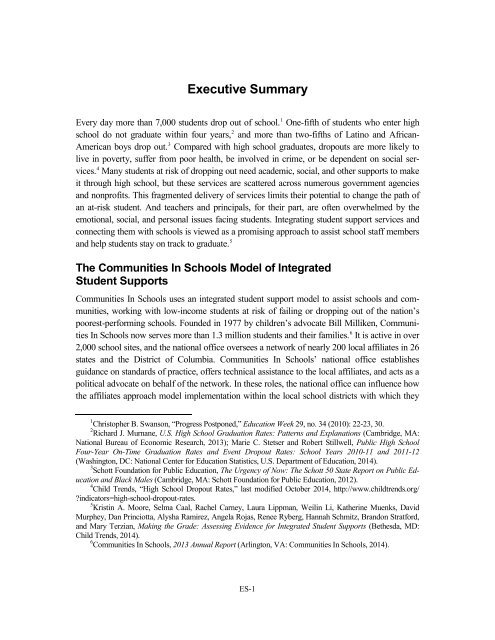NNFGV
NNFGV
NNFGV
You also want an ePaper? Increase the reach of your titles
YUMPU automatically turns print PDFs into web optimized ePapers that Google loves.
Executive Summary<br />
Every day more than 7,000 students drop out of school. 1 One-fifth of students who enter high<br />
school do not graduate within four years, 2 and more than two-fifths of Latino and African-<br />
American boys drop out. 3 Compared with high school graduates, dropouts are more likely to<br />
live in poverty, suffer from poor health, be involved in crime, or be dependent on social services.<br />
4 Many students at risk of dropping out need academic, social, and other supports to make<br />
it through high school, but these services are scattered across numerous government agencies<br />
and nonprofits. This fragmented delivery of services limits their potential to change the path of<br />
an at-risk student. And teachers and principals, for their part, are often overwhelmed by the<br />
emotional, social, and personal issues facing students. Integrating student support services and<br />
connecting them with schools is viewed as a promising approach to assist school staff members<br />
and help students stay on track to graduate. 5<br />
The Communities In Schools Model of Integrated<br />
Student Supports<br />
Communities In Schools uses an integrated student support model to assist schools and communities,<br />
working with low-income students at risk of failing or dropping out of the nation’s<br />
poorest-performing schools. Founded in 1977 by children’s advocate Bill Milliken, Communities<br />
In Schools now serves more than 1.3 million students and their families. 6 It is active in over<br />
2,000 school sites, and the national office oversees a network of nearly 200 local affiliates in 26<br />
states and the District of Columbia. Communities In Schools’ national office establishes<br />
guidance on standards of practice, offers technical assistance to the local affiliates, and acts as a<br />
political advocate on behalf of the network. In these roles, the national office can influence how<br />
the affiliates approach model implementation within the local school districts with which they<br />
1 Christopher B. Swanson, “Progress Postponed,” Education Week 29, no. 34 (2010): 22-23, 30.<br />
2 Richard J. Murnane, U.S. High School Graduation Rates: Patterns and Explanations (Cambridge, MA:<br />
National Bureau of Economic Research, 2013); Marie C. Stetser and Robert Stillwell, Public High School<br />
Four-Year On-Time Graduation Rates and Event Dropout Rates: School Years 2010-11 and 2011-12<br />
(Washington, DC: National Center for Education Statistics, U.S. Department of Education, 2014).<br />
3 Schott Foundation for Public Education, The Urgency of Now: The Schott 50 State Report on Public Education<br />
and Black Males (Cambridge, MA: Schott Foundation for Public Education, 2012).<br />
4 Child Trends, “High School Dropout Rates,” last modified October 2014, http://www.childtrends.org/<br />
?indicators=high-school-dropout-rates.<br />
5 Kristin A. Moore, Selma Caal, Rachel Carney, Laura Lippman, Weilin Li, Katherine Muenks, David<br />
Murphey, Dan Princiotta, Alysha Ramirez, Angela Rojas, Renee Ryberg, Hannah Schmitz, Brandon Stratford,<br />
and Mary Terzian, Making the Grade: Assessing Evidence for Integrated Student Supports (Bethesda, MD:<br />
Child Trends, 2014).<br />
6 Communities In Schools, 2013 Annual Report (Arlington, VA: Communities In Schools, 2014).<br />
ES-1


